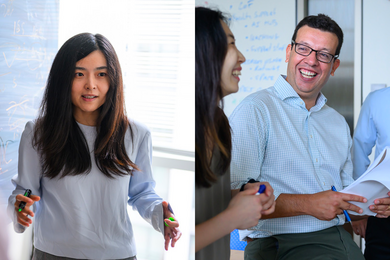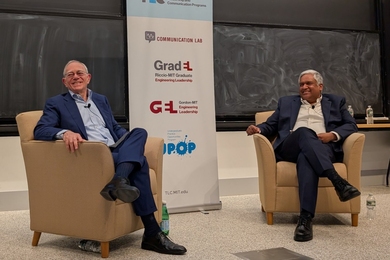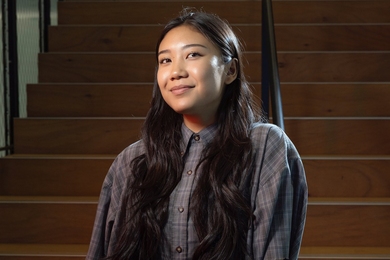The first round of seniors to complete the new civil engineering curriculum pitted body weight against brain power this semester when they stood as a group on a bridge they'd built to test its weight-bearing ability.
In the last six weeks of 1.013 (Civil Engineering Design Project), civil engineering seniors were required to design and build a lightweight bridge spanning 10 feet that could hold up to 2,000 pounds. The idea was to make a portable bridge that could be quickly and cheaply built with local materials by unskilled laborers, then hand-carried to impassable streams in savannah-type developing countries where heavy rains create temporary flooding. Each of the two teams was given $200 to spend at Home Depot. With the supplies they bought and the knowledge they'd gained in four years at MIT, the students set to work, approaching the problems in radically different ways, according to Professor Herbert Einstein of civil and environmental engineering, lead instructor for the course.
"They used two very different approaches to design," he said. "The first group put it all down on paper and figured everything out first. The other group started with a concept, then built it and worked with it after it was built."
The all-male, concept-oriented team brainstormed one evening at a fraternity house and came up with a parabolic design -- a boat-shaped bridge made of stacked layers of styrofoam sandwiched between nylon ropes and wood. On test day, that bridge carried the load of the team's combined weight plus stacked concrete blocks, but it didn't fare as well on deflections -- the bridge's deformation under load.
The other team of three women and one man approached the problem more traditionally, building a flat-bottomed truss bridge of PVC pipes bound between plywood. One of the truss cables snapped under the load of students and blocks. "But the loads were transferred beautifully to the other [cables] that were built in," said Jennifer Burtz, a third-year senior from Hollywood, FL. "We proved the necessity of redundancy in building.
"When we had our bridge design on paper, it was a lot different than trying to put it together," said Ms. Burtz, who thought the project was effective in forcing students to draw upon everything they had learned in coursework. "We had to work with materials that we hadn't analyzed in class. We hadn't been taught how wood or PVC pipe performs in connection with other materials. And the materials we had been taught to analyze, like steel and concrete, wouldn't work for this project. We had to use our intuition and extrapolate our knowledge to new situations."
"This is the first graduating class under the new curriculum, and I never thought it would work out so well," said Professor Einstein, who seemed pleased as punch with his students' accomplishments. "I was afraid they would not have time enough or would cut their fingers. But this was one of those really satisfactory experiences of being on the faculty at this place. You let the students go and they do great things."
A version of this article appeared in MIT Tech Talk on June 6, 2001.





